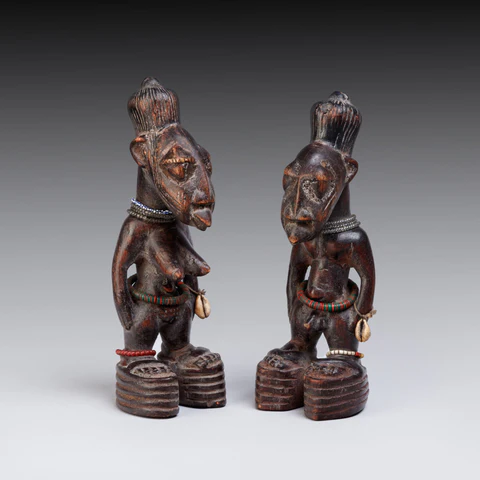In this article, we’ll take you on a journey deep into the heart of Yoruba culture, exploring the fascinating history, artistic traditions, and customary beliefs surrounding the sacred twins’ sculptures, known as Ere Ibeji.
Yoruba Twins: A Remarkable Phenomenon
Among the Yoruba people of West Africa, the twinning rate is one of the highest in the world, with an estimated 4.5% of births involving twins. To put it into perspective, every eleventh Yoruba child is likely to be a twin. This unique phenomenon has had a profound impact on Yoruba culture and their artistic expression.
A Historical Transformation: The Oracle’s Verdict
Centuries ago, the Yoruba people underwent a profound shift in their perception of twins. During the 18th century, a cloud of inexplicable sadness hung over their communities. In this dire atmosphere, they turned to the Ifa Oracle for guidance. The Oracle’s verdict was clear: twins were to be revered, respected, and honored. This divine proclamation put an end to the tragic practice of killing twins and ushered in an era of happiness and celebration.
King Ajaka and the Birth of Sacred Sculptures
Another legend speaks of King Ajaka, the brother of Sango, the god of thunder. It is uncertain whether King Ajaka himself was a twin, but the prevalence of twin-related prejudice during his time likely influenced his decision to introduce the practice of carving sacred sculptures for twins. These sculptures would become central to Yoruba culture and spirituality.
Artistic Tradition: Celebrating Twins with Grandeur
In the past, the birth of twins was a cause for grand celebrations. New mothers were treated to the finest delicacies, clothing, and accessories, while the community and neighboring villages joined in congratulating them. An exclusive dance ritual, symbolising prosperity, happiness, and protection against malevolent forces, was performed by other mothers of twins.
Customary Beliefs and the Role of Sacred Sculptures
The consecration of newborn twins to the deity of twins, Orisa Ibeji, is a crucial ceremony carried out by the Babalawo, the Chief Priest, shortly after birth. This ritual is believed to bind the twins’ souls together, making the survival of one twin dependent on the other. To avert misfortune should one twin pass away, the Babalawo is consulted to create sacred sculptures. These sculptures serve as a vessel for the departed twin’s soul and a means of appeasing the surviving twin’s soul.
The mother plays an active role in caring for the sacred sculpture of the deceased twin, treating it with the same love and care as the living twin. Conversations with the sculptures and placement near her bed and place of worship help maintain a spiritual connection. Even when breastfeeding the living twin, the same gesture is extended to the sacred sculpture of the departed twin. Camwood is used for bathing the sculptures, and in dire situations, the Chief Priest may make incisions on both sculptures to avert danger from the living twin.
Conclusion: A Living Tradition
The Yoruba sacred twins’ sculptures, or Ere Ibeji, are more than just artistic masterpieces; they are living symbols of a culture deeply rooted in tradition, spirituality, and reverence for the miracle of twinning. As we explore the intricate carvings and spiritual significance of these sculptures, we gain insight into the profound connection between the Yoruba people, their art, and their beliefs. Ere Ibeji invites us to celebrate the beauty and complexity of African culture and its enduring artistic legacy.

